Goma Tourism offers a unique, albeit challenging, travel experience, and SIXT.VN is here to help you navigate it. While Goma may not be the typical tourist destination, its resilience, culture, and proximity to natural wonders make it a compelling place to visit, with insights into Congo’s history and the beauty of Lake Kivu. With SIXT.VN’s expertise, you can explore Goma with ease, safety, and comfort. Discover reliable airport transfers, comfortable hotel bookings, and expert advice for a seamless journey.
1. What Makes Goma Tourism Unique?
Goma tourism is unique because it offers a raw and unfiltered glimpse into a city shaped by both natural disasters and human resilience. Instead of manicured tourist attractions, Goma offers an immersive experience in a place striving to rebuild. Goma is a city unlike any other, offering an authentic, if challenging, travel experience. The city bears the scars of volcanic eruptions and conflict, yet its people display remarkable resilience and warmth.
- Resilience in the Face of Adversity: Goma has faced numerous challenges, including volcanic eruptions and armed conflicts. The city’s ability to rebuild and maintain a sense of community is truly inspiring.
- Cultural Immersion: Goma offers a unique opportunity to experience Congolese culture firsthand. From bustling markets to vibrant churches, the city’s cultural scene is rich and diverse.
- Proximity to Natural Wonders: Goma serves as a gateway to some of the region’s most stunning natural attractions, including Virunga National Park and Lake Kivu.
2. What Challenges Do Tourists Face in Goma?
Tourists in Goma face several challenges, from safety concerns to logistical difficulties. However, with careful planning and the right support, these challenges can be overcome. According to a 2022 report by the United Nations, Goma has faced significant security challenges due to ongoing conflicts in the region. However, with SIXT.VN’s assistance, tourists can overcome these hurdles and enjoy a meaningful travel experience.
- Safety and Security: Goma has experienced periods of instability due to ongoing conflicts. It’s essential to stay informed about the current security situation and take necessary precautions.
- Infrastructure: The city’s infrastructure is still developing, which can make transportation and accommodation challenging.
- Language Barrier: French is the official language of the Democratic Republic of Congo, so English-speaking travelers may encounter communication difficulties.
3. How Can SIXT.VN Help with Goma Tourism?
SIXT.VN offers a range of services to support tourists visiting Goma, including airport transfers, hotel bookings, and expert travel advice. SIXT.VN ensures a smooth and hassle-free travel experience for those venturing into this unique destination.
- Airport Transfers: SIXT.VN provides reliable and safe airport transfers, ensuring a seamless arrival and departure experience.
- Hotel Bookings: SIXT.VN offers a curated selection of hotels in Goma, catering to various budgets and preferences.
- Expert Travel Advice: SIXT.VN’s team of travel experts provides up-to-date information and guidance on safety, cultural norms, and must-see attractions.
4. What Are the Must-See Attractions in Goma?
While Goma may not be known for traditional tourist attractions, the city offers unique sights and experiences. The volcano memorial and local markets provide glimpses into Goma’s history and culture.
- Volcano Memorial: This memorial commemorates the devastating 2002 volcanic eruption that significantly impacted Goma.
- Local Markets: Goma’s markets offer a vibrant and authentic cultural experience, with opportunities to interact with locals and purchase unique souvenirs.
- Lake Kivu: This beautiful lake offers stunning views and opportunities for relaxation and water activities.
5. What is the Significance of the Lava Walls in Goma?
The lava walls in Goma are a testament to the city’s resilience and resourcefulness. After the 2002 volcanic eruption, residents used the lava to rebuild their homes and create barriers, turning a destructive force into a symbol of strength. According to a 2020 study by the Goma Volcano Observatory, the lava walls serve as a constant reminder of the city’s history and the community’s ability to adapt.
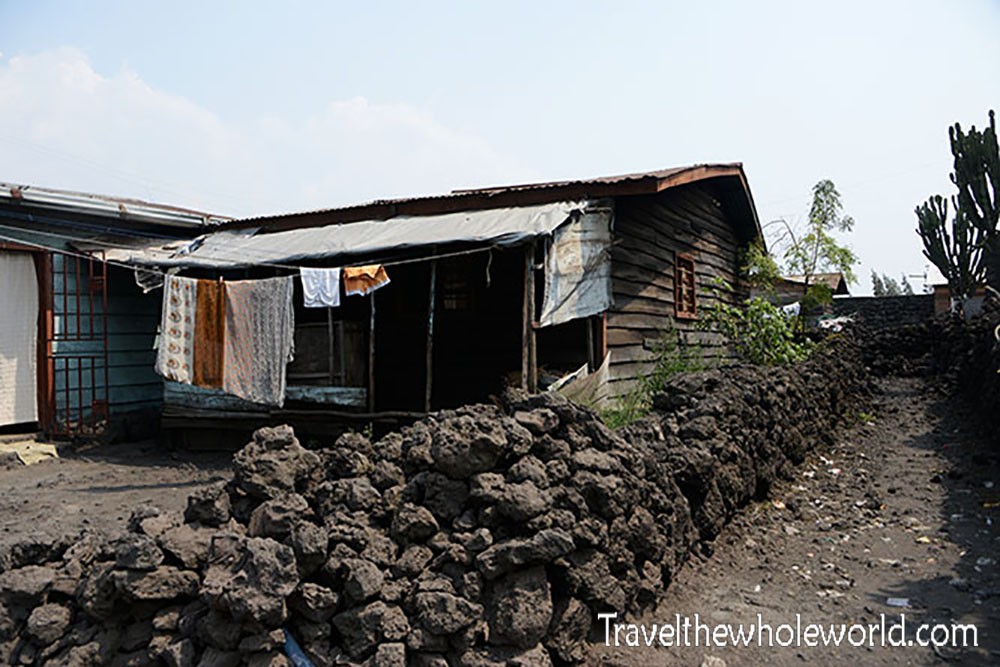 Lava fence in Goma, a practical and creative use of volcanic rock
Lava fence in Goma, a practical and creative use of volcanic rock
6. What Role Does the UN Play in Goma?
The United Nations has a significant presence in Goma, with troops and bases throughout the city. The UN’s mission is to maintain stability and support the Congolese government in its efforts to rebuild and develop the region. According to the United Nations Organization Stabilization Mission in the Democratic Republic of the Congo (MONUSCO), the UN’s role in Goma includes protecting civilians, supporting peace processes, and promoting human rights.
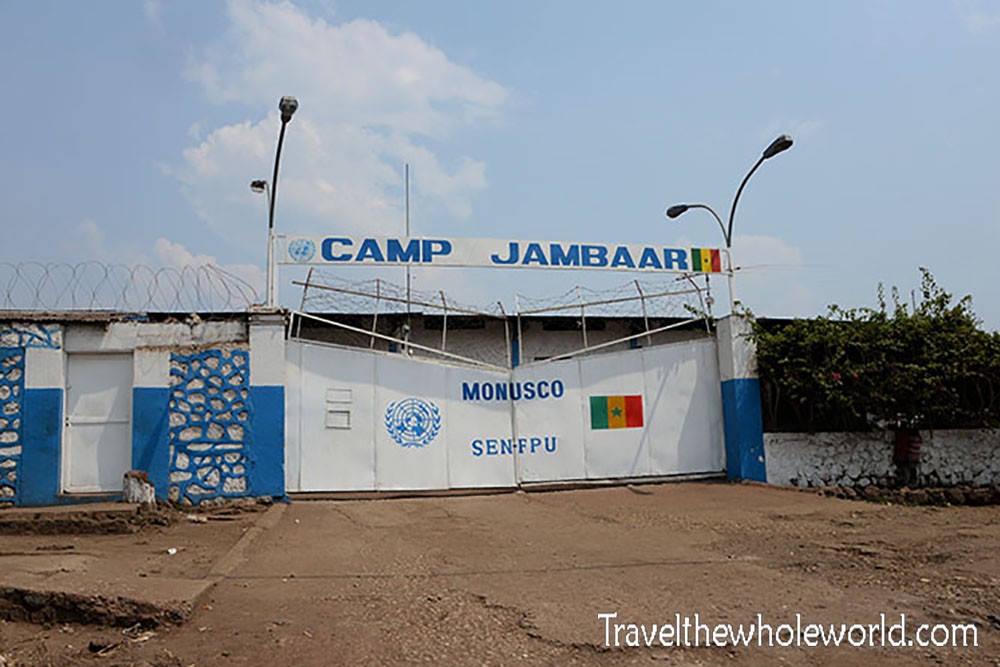 UN base in Goma, a common sight in the city
UN base in Goma, a common sight in the city
7. What is the Historical Significance of Goma?
Goma has a rich and complex history, dating back to World War I when German, British, and Belgian troops fought in the region. The city’s location on the border between Rwanda and the Democratic Republic of Congo has made it a strategic point throughout history.
- World War I: Goma was the site of battles between German, British, and Belgian forces. The German loss in this war led to the region becoming a Belgian colony.
- Colonial Era: Goma was part of the Belgian Congo, which gained independence in 1960 and became the Democratic Republic of Congo.
- Recent Conflicts: Goma has been affected by numerous conflicts in recent decades, including the Rwandan genocide and the ongoing conflicts in the eastern Congo.
8. What is the “Black Market” in Goma?
Goma’s “Black Market” is a bustling marketplace where you can find a variety of goods, from everyday items to knock-off products. While the name may suggest illicit activities, the market is generally open and accessible. The “Black Market” is a reflection of Goma’s informal economy and the resourcefulness of its residents.
9. What Cultural Norms Should Tourists Be Aware Of in Goma?
When visiting Goma, it’s essential to be aware of and respect local cultural norms. Understanding these customs will help you have a more positive and meaningful travel experience.
- Photography: Be mindful when taking photos, as some people may not want to be photographed. Always ask for permission before taking someone’s picture.
- Dress Code: Dress modestly, especially when visiting religious sites.
- Greetings: Greet people with a handshake and a smile.
- Language: French is the official language, so learning a few basic phrases will be helpful.
- Respect: Show respect for local customs and traditions.
10. What Can Tourists Expect to See in Goma’s Markets?
Goma’s markets offer a vibrant and authentic cultural experience. You can expect to see a variety of goods, from fresh produce and fish to clothing and handicrafts. The markets are also a great place to interact with locals and learn about their daily lives.
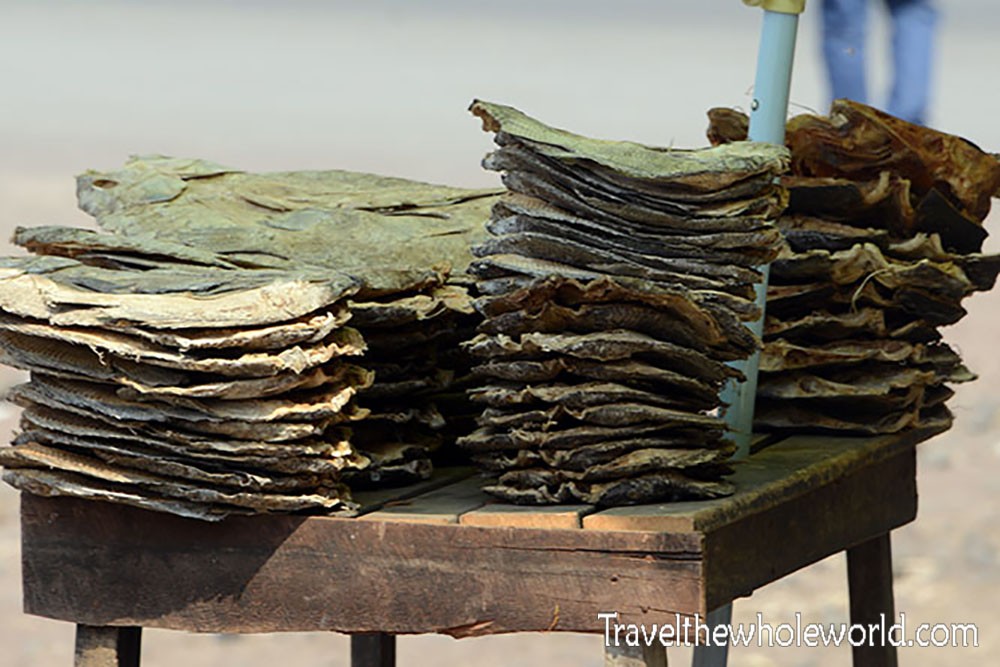 Fish for sale in Goma's market, a common sight
Fish for sale in Goma's market, a common sight
11. How Do Locals in Goma Transport Goods?
Locals in Goma use a variety of methods to transport goods, including wooden bikes and carrying items on their backs. The wooden bikes are a unique and resourceful adaptation to the city’s challenging infrastructure.
- Wooden Bikes: These bikes are made entirely of wood and are used to transport heavy goods.
- Head Carrying: Women often carry heavy loads on their heads, a common practice in many parts of Africa.
- Trucks and Vans: Trucks and vans are used to transport larger quantities of goods.
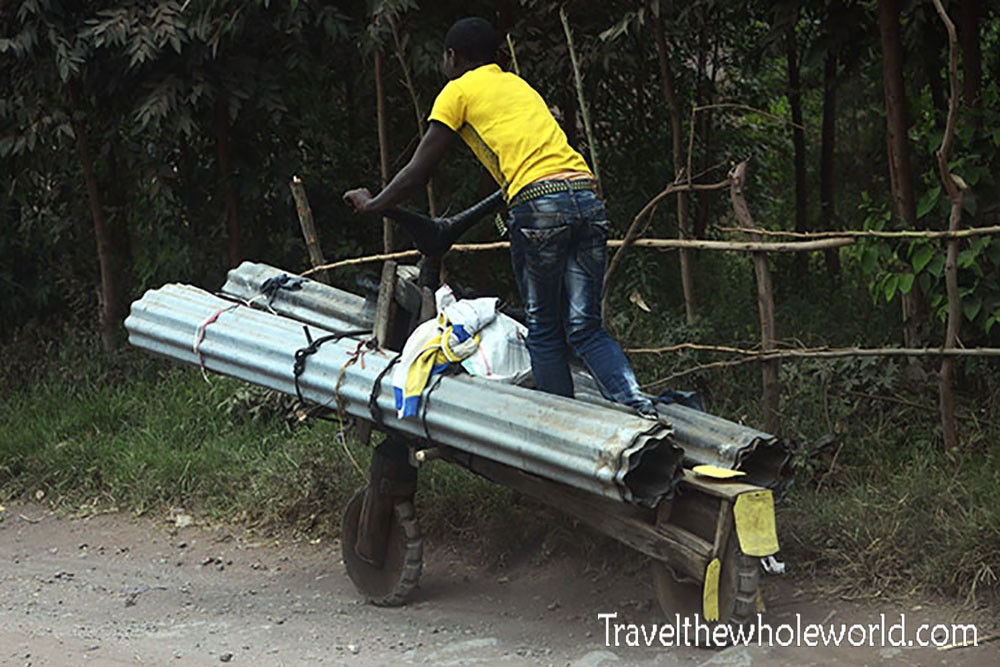 Wooden bike in Goma, a unique mode of transport
Wooden bike in Goma, a unique mode of transport
12. What is the Significance of Charcoal in Goma?
Charcoal is a vital commodity in Goma, as it is used for cooking in most households. The production and sale of charcoal provide livelihoods for many people in the city.
- Cooking Fuel: Charcoal is the primary cooking fuel for most households in Goma.
- Economic Importance: The charcoal industry provides income for many people in the city.
- Environmental Concerns: The production of charcoal can contribute to deforestation and environmental degradation.
13. What Are the Churches in Goma?
Goma has several large churches, including the Cathedral of Dadoration and the Kanisa La Mangu Church. These churches are important centers of religious and community life in the city.
- Cathedral of Dadoration: This cathedral was destroyed by the 2002 volcanic eruption and rebuilt.
- Kanisa La Mangu Church: This church is another prominent religious site in Goma.
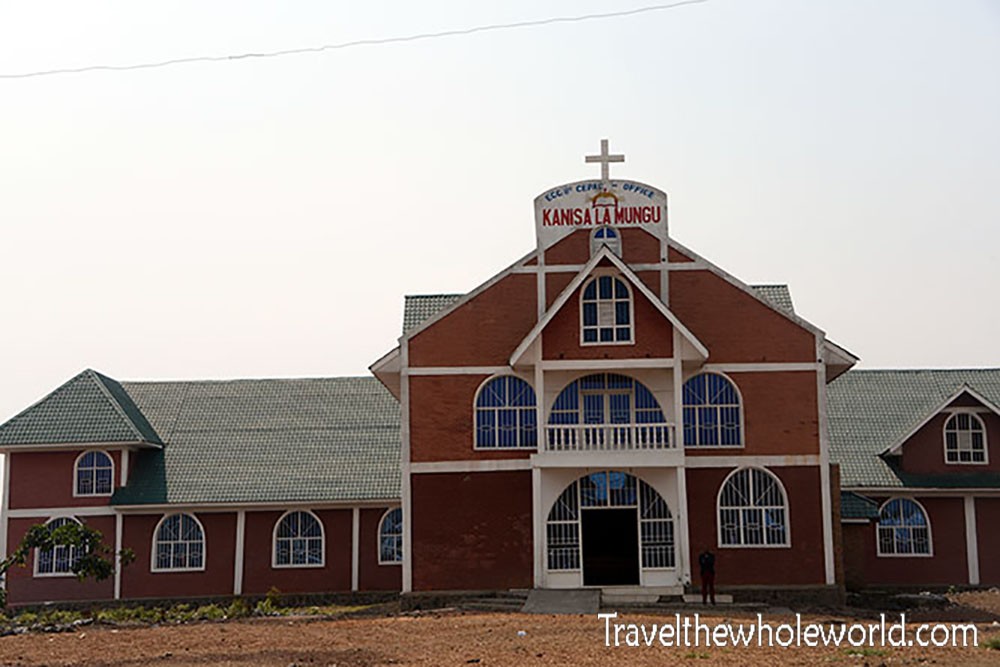 Kanisa La Mangu Church in Goma, a prominent religious site
Kanisa La Mangu Church in Goma, a prominent religious site
14. What is the Current Security Situation in Goma?
The security situation in Goma can be unpredictable, with ongoing conflicts in the region. It’s essential to stay informed about the current situation and take necessary precautions. SIXT.VN provides up-to-date travel advice and safety information to help you navigate Goma safely.
- Ongoing Conflicts: Goma has been affected by ongoing conflicts in the eastern Congo.
- UN Presence: The United Nations has a significant presence in Goma to maintain stability and protect civilians.
- Travel Advice: Stay informed about the current security situation and follow the advice of local authorities and travel experts.
15. What Are the Key Considerations for Planning a Trip to Goma?
Planning a trip to Goma requires careful consideration of safety, logistics, and cultural norms. With SIXT.VN’s support, you can plan a successful and rewarding trip to this unique destination.
- Safety: Stay informed about the current security situation and take necessary precautions.
- Logistics: Plan your transportation and accommodation in advance.
- Cultural Sensitivity: Be aware of and respect local cultural norms.
- Travel Insurance: Purchase comprehensive travel insurance that covers medical emergencies and evacuation.
- Visa Requirements: Check visa requirements and ensure you have the necessary documents.
16. What Types of Accommodation Are Available in Goma?
Goma offers a range of accommodation options, from budget-friendly guesthouses to more comfortable hotels. SIXT.VN can help you find the perfect accommodation to suit your needs and budget.
- Guesthouses: Guesthouses are a budget-friendly option, offering basic amenities and a chance to interact with locals.
- Hotels: Goma has several hotels that offer more comfortable amenities and services.
- Apartments: Apartments are a good option for longer stays, offering more space and privacy.
17. How Can Tourists Get Around Goma?
Getting around Goma can be challenging due to the city’s developing infrastructure. However, several transportation options are available.
- Taxis: Taxis are a convenient way to get around Goma, but be sure to negotiate the fare in advance.
- Motorcycle Taxis: Motorcycle taxis (moto-taxis) are a faster and more affordable option, but they can be less safe.
- Rental Cars: Renting a car is possible, but it’s recommended to hire a driver due to the challenging road conditions.
18. What Kind of Food Can Tourists Expect to Find in Goma?
Goma’s cuisine reflects its location in Central Africa, with a mix of local and international influences. You can expect to find dishes made with ingredients like cassava, plantains, beans, and fish.
- Local Dishes: Try local specialties like fufu (a dough made from cassava) and madesu (beans).
- Grilled Fish: Freshly grilled fish from Lake Kivu is a must-try.
- International Cuisine: Goma also has restaurants that offer international cuisine, including French and Italian dishes.
19. What is the Best Time of Year to Visit Goma?
The best time to visit Goma is during the dry season, which runs from June to September. During this time, the weather is more pleasant, and the roads are more accessible.
- Dry Season (June-September): This is the best time to visit, with less rain and more pleasant temperatures.
- Rainy Season (October-May): The rainy season can make transportation difficult and some roads may be impassable.
20. What Should Tourists Pack for a Trip to Goma?
Packing for a trip to Goma requires considering the city’s climate, cultural norms, and potential safety concerns.
- Lightweight Clothing: Pack lightweight, breathable clothing suitable for warm weather.
- Rain Gear: If traveling during the rainy season, bring rain gear like a raincoat and waterproof shoes.
- Comfortable Shoes: Wear comfortable shoes for walking on uneven terrain.
- Insect Repellent: Protect yourself from mosquitoes and other insects.
- First-Aid Kit: Bring a basic first-aid kit with essential medications.
- Flashlight: A flashlight can be useful during power outages.
- Copies of Important Documents: Make copies of your passport, visa, and other important documents.
21. What Are Some Day Trips That Tourists Can Take from Goma?
Goma is a great base for exploring the surrounding region, with several day trip options available.
- Virunga National Park: Visit Virunga National Park, home to endangered mountain gorillas and stunning volcanic landscapes.
- Lake Kivu: Take a boat trip on Lake Kivu and enjoy the beautiful scenery.
- Mount Nyiragongo: Hike to the summit of Mount Nyiragongo, an active volcano with a lava lake.
22. What Are the Top Safety Tips for Tourists Visiting Goma?
Safety is a top priority when visiting Goma. By following these tips, you can minimize risks and enjoy a safe and rewarding trip.
- Stay Informed: Stay updated on the current security situation and follow the advice of local authorities and travel experts.
- Avoid Walking Alone at Night: Avoid walking alone at night, especially in unfamiliar areas.
- Keep Valuables Hidden: Keep valuables hidden and avoid displaying expensive jewelry or electronics.
- Use Reputable Transportation: Use reputable transportation services and avoid unmarked taxis.
- Be Aware of Your Surroundings: Be aware of your surroundings and avoid drawing attention to yourself.
- Trust Your Instincts: If something feels wrong, trust your instincts and remove yourself from the situation.
23. How Can Tourists Support the Local Economy in Goma?
Tourists can support the local economy in Goma by patronizing local businesses and purchasing locally made products.
- Shop at Local Markets: Buy souvenirs and other items from local markets.
- Eat at Local Restaurants: Try local cuisine at restaurants run by local people.
- Hire Local Guides: Hire local guides to show you around the city and surrounding areas.
- Stay at Locally Owned Accommodations: Choose locally owned guesthouses or hotels.
24. What Are Some Common Misconceptions About Goma?
There are several common misconceptions about Goma, often based on outdated or incomplete information.
- Goma is a War Zone: While Goma has experienced periods of conflict, it is not constantly at war.
- Goma is Unsafe for Tourists: With proper precautions, Goma can be a safe destination for tourists.
- Goma Has Nothing to Offer Tourists: Goma offers unique cultural experiences and access to stunning natural attractions.
25. How Does Goma’s History of Volcanic Eruptions Impact Tourism?
Goma’s history of volcanic eruptions has had a profound impact on tourism. While the eruptions have caused significant damage, they have also created unique landscapes and attractions.
- Lava Fields: The lava fields created by volcanic eruptions are a unique sight and a reminder of the city’s history.
- Volcano Tourism: Mount Nyiragongo, an active volcano near Goma, is a popular tourist destination.
- Resilience: The city’s resilience in the face of volcanic eruptions is an inspiring story that attracts visitors.
26. What Role Does Agriculture Play in Goma’s Economy?
Agriculture is an important part of Goma’s economy, with many people involved in farming and food production.
- Local Farms: Local farms produce a variety of crops, including cassava, plantains, beans, and vegetables.
- Markets: The local markets are a hub for buying and selling agricultural products.
- Food Security: Agriculture plays a vital role in ensuring food security for the city’s residents.
27. What Are the Challenges and Opportunities for Sustainable Tourism in Goma?
Sustainable tourism has the potential to benefit Goma’s economy and environment, but it also faces challenges.
- Challenges:
- Environmental Impact: Tourism can have a negative impact on the environment, including pollution and deforestation.
- Cultural Preservation: Tourism can threaten local cultures and traditions.
- Infrastructure: Goma’s developing infrastructure can struggle to support a large influx of tourists.
- Opportunities:
- Economic Development: Tourism can create jobs and generate income for local communities.
- Environmental Conservation: Tourism can provide funding for conservation efforts.
- Cultural Exchange: Tourism can promote cultural exchange and understanding.
28. What Are the Main Languages Spoken in Goma?
The main languages spoken in Goma are French and Swahili. French is the official language of the Democratic Republic of Congo, while Swahili is a widely spoken regional language.
- French: French is the language of government, education, and business.
- Swahili: Swahili is spoken by many people in eastern Congo and neighboring countries.
- Local Languages: Other local languages are also spoken in Goma.
29. How Can Tourists Learn More About Goma’s Culture and History?
Tourists can learn more about Goma’s culture and history by visiting local museums, talking to local people, and reading books and articles about the city.
- Local Museums: Visit local museums to learn about Goma’s history and culture.
- Talk to Local People: Interact with local people and ask them about their lives and experiences.
- Read Books and Articles: Read books and articles about Goma’s history and culture.
30. What is the Best Way to Prepare for a Trip to Goma?
Preparing for a trip to Goma involves researching the city, planning your itinerary, and packing the necessary items.
- Research Goma: Learn about the city’s history, culture, and attractions.
- Plan Your Itinerary: Plan your itinerary in advance, including transportation and accommodation.
- Pack the Necessary Items: Pack the necessary clothing, gear, and medications.
- Learn Basic French Phrases: Learning a few basic French phrases will be helpful.
- Get Travel Insurance: Purchase comprehensive travel insurance that covers medical emergencies and evacuation.
31. What Are Some Useful Resources for Planning a Trip to Goma?
There are several useful resources for planning a trip to Goma, including travel websites, guidebooks, and online forums.
- Travel Websites: Websites like TripAdvisor, Booking.com, and Lonely Planet offer information and reviews about Goma.
- Guidebooks: Guidebooks like Lonely Planet and Bradt Travel Guides provide detailed information about Goma and the surrounding region.
- Online Forums: Online forums like TripAdvisor and Lonely Planet’s Thorn Tree forum are great places to ask questions and get advice from other travelers.
32. What Are the Emerging Trends in Goma Tourism?
Goma tourism is evolving, with new trends and opportunities emerging.
- Ecotourism: Ecotourism is becoming increasingly popular, with visitors seeking to experience the region’s natural beauty while minimizing their environmental impact.
- Cultural Tourism: Cultural tourism is also growing, with visitors interested in learning about Goma’s unique culture and traditions.
- Adventure Tourism: Adventure tourism, such as hiking Mount Nyiragongo, is attracting more visitors to the region.
33. How Can SIXT.VN Contribute to the Growth of Sustainable Tourism in Goma?
SIXT.VN can play a key role in promoting sustainable tourism in Goma by:
- Partnering with Local Businesses: Partnering with local businesses to support the local economy.
- Promoting Responsible Travel Practices: Promoting responsible travel practices among its customers.
- Supporting Conservation Efforts: Supporting conservation efforts to protect the region’s natural environment.
- Educating Travelers: Educating travelers about Goma’s culture and environment.
34. What Unique Cultural Experiences Can Tourists Have in Goma?
Goma offers a range of unique cultural experiences, from visiting local markets to attending religious ceremonies.
- Local Markets: Visit local markets to experience the vibrant atmosphere and interact with local people.
- Religious Ceremonies: Attend religious ceremonies to learn about Goma’s religious traditions.
- Traditional Music and Dance: Experience traditional music and dance performances.
- Art and Handicrafts: Visit local art galleries and handicraft shops.
35. How Does the Presence of NGOs Impact Goma Tourism?
The presence of numerous NGOs in Goma has a significant impact on tourism.
- Infrastructure Development: NGOs have contributed to the development of Goma’s infrastructure, which benefits tourism.
- Safety and Security: NGOs have also worked to improve safety and security in the city, making it a more attractive destination for tourists.
- Economic Impact: NGOs have created jobs and stimulated the local economy, which indirectly benefits tourism.
36. What Are Some Responsible Travel Practices for Tourists in Goma?
Responsible travel practices are essential for minimizing the negative impacts of tourism and maximizing its benefits for local communities.
- Respect Local Culture: Respect local customs and traditions.
- Support Local Businesses: Patronize local businesses and purchase locally made products.
- Minimize Environmental Impact: Minimize your environmental impact by reducing waste and conserving resources.
- Be Mindful of Photography: Be mindful when taking photos and ask for permission before photographing people.
- Learn Basic Phrases in Local Languages: Learning a few basic phrases in local languages will be helpful.
37. What Are the Top Wildlife Viewing Opportunities Near Goma?
Goma is a gateway to some of Africa’s best wildlife viewing opportunities.
- Virunga National Park: Visit Virunga National Park to see endangered mountain gorillas, chimpanzees, and other wildlife.
- Kahuzi-Biega National Park: Visit Kahuzi-Biega National Park to see eastern lowland gorillas.
- Okapi Wildlife Reserve: Visit the Okapi Wildlife Reserve to see okapis, a unique species of giraffe.
38. What Are the Key Events and Festivals in Goma?
Goma hosts several events and festivals throughout the year.
- Goma International Film Festival: The Goma International Film Festival showcases films from around the world.
- Amani Festival: The Amani Festival promotes peace and reconciliation through music and dance.
- Independence Day: Independence Day is celebrated on June 30th.
39. What Are the Top Tips for Photographing Goma?
Photographing Goma can be a rewarding experience, but it’s important to be respectful and mindful of local customs.
- Ask for Permission: Always ask for permission before photographing people.
- Be Respectful: Be respectful of local customs and traditions.
- Use Natural Light: Use natural light whenever possible.
- Capture the City’s Resilience: Capture the city’s resilience and spirit in your photos.
- Experiment with Different Angles: Experiment with different angles and perspectives.
40. How Does the Weather in Goma Affect Travel Planning?
The weather in Goma can significantly affect travel planning.
- Dry Season (June-September): The dry season is the best time to visit, with less rain and more pleasant temperatures.
- Rainy Season (October-May): The rainy season can make transportation difficult and some roads may be impassable.
- Pack Accordingly: Pack lightweight clothing for warm weather and rain gear for the rainy season.
41. What Are the Benefits of Using SIXT.VN for Travel Arrangements in Goma?
Using SIXT.VN for travel arrangements in Goma offers several benefits.
- Convenience: SIXT.VN offers a convenient way to book airport transfers, hotels, and tours.
- Reliability: SIXT.VN provides reliable and safe services.
- Expert Advice: SIXT.VN’s team of travel experts can provide up-to-date information and guidance.
- Support: SIXT.VN offers 24/7 customer support.
- Peace of Mind: With SIXT.VN, you can travel with peace of mind knowing that your travel arrangements are in good hands.
42. What Are the Different Types of Visas Required to Visit Goma?
To visit Goma, you typically need a visa for the Democratic Republic of Congo. The type of visa you need depends on the purpose of your visit.
- Tourist Visa: For leisure travel and tourism.
- Business Visa: For business-related activities, such as meetings and conferences.
- Transit Visa: For travelers passing through the DRC to another destination.
It’s crucial to check the specific visa requirements with the Congolese embassy or consulate in your country well in advance of your trip.
43. How Can Tourists Ensure They Are Using Ethical and Sustainable Tour Operators in Goma?
Choosing ethical and sustainable tour operators is vital for responsible tourism in Goma. Here are some ways to ensure you’re making a positive impact:
- Research: Look for tour operators with a strong commitment to environmental and social responsibility.
- Certifications: Check if the operator has any certifications or accreditations related to sustainable tourism.
- Community Involvement: Inquire about the operator’s involvement in local community projects.
- Environmental Practices: Ask about the operator’s environmental practices, such as waste management and conservation efforts.
- Fair Labor Practices: Ensure the operator provides fair wages and working conditions for their employees.
44. What Are Some Less-Known or Hidden Gems to Explore Near Goma?
Beyond the main attractions, there are some less-known gems to discover near Goma:
- Tchegera Island: A tranquil island in Lake Kivu, perfect for relaxation and birdwatching.
- Idjwi Island: The second-largest inland island in Africa, offering stunning scenery and a glimpse into local life.
- Local Coffee Plantations: Visit coffee plantations in the surrounding hills and learn about the coffee-making process.
- Waterfalls: Explore hidden waterfalls in the lush forests near Goma.
45. How Can Travelers Stay Connected to the Internet in Goma?
Staying connected to the internet can be challenging in Goma, but here are some options:
- Hotels: Some hotels offer Wi-Fi, but the connection may be slow or unreliable.
- Mobile Data: Purchase a local SIM card with a data plan.
- Internet Cafes: Internet cafes are available in Goma, but the speed and security may vary.
- Satellite Internet: Satellite internet is an option for those who need a reliable connection, but it can be expensive.
46. What Are the Best Souvenirs to Buy in Goma?
Souvenirs from Goma can be a great way to remember your trip and support local artisans:
- Wood Carvings: Intricately carved wooden sculptures and figurines.
- Batik Fabrics: Colorful fabrics with traditional designs.
- Coffee: Locally grown coffee beans or ground coffee.
- Jewelry: Handmade jewelry using local materials.
- Artwork: Paintings and other artwork depicting Goma’s culture and landscapes.
47. How Can Tourists Learn Basic Phrases in French or Swahili Before Visiting Goma?
Learning basic phrases in French or Swahili can enhance your experience in Goma and show respect for the local culture.
- Language Learning Apps: Use apps like Duolingo, Memrise, or Babbel to learn basic phrases.
- Online Courses: Take online courses in French or Swahili.
- Phrasebooks: Purchase a phrasebook with essential phrases.
- Language Exchange Partners: Find a language exchange partner online to practice speaking.
48. What Health Precautions Should Tourists Take Before Traveling to Goma?
Before traveling to Goma, it’s important to take certain health precautions:
- Vaccinations: Consult your doctor about recommended vaccinations, such as yellow fever, typhoid, and hepatitis A.
- Malaria Prevention: Take malaria prophylaxis as prescribed by your doctor.
- Travel Insurance: Ensure you have comprehensive travel insurance that covers medical emergencies.
- First-Aid Kit: Pack a basic first-aid kit with essential medications.
- Consult Your Doctor: Consult your doctor about any other health concerns or precautions.
49. How Can Tourists Contribute to the Conservation of Virunga National Park?
Virunga National Park is a precious natural resource, and tourists can contribute to its conservation by:
- Choosing Responsible Tour Operators: Select tour operators that support conservation efforts.
- Following Park Rules: Adhere to all park rules and regulations.
- Respecting Wildlife: Maintain a safe distance from wildlife and avoid disturbing their habitat.
- Donating to Conservation Organizations: Donate to organizations that support Virunga National Park.
- Raising Awareness: Raise awareness about the importance of conserving Virunga National Park.
50. How Can SIXT.VN Personalize Travel Experiences for Different Types of Tourists Visiting Goma?
SIXT.VN can personalize travel experiences for different types of tourists visiting Goma by:
- Tailoring Itineraries: Creating customized itineraries based on individual interests and preferences.
- Offering a Range of Accommodation Options: Providing a selection of accommodation options to suit different budgets and needs.
- Providing Expert Guides: Offering expert guides who can provide insights into Goma’s culture and history.
- Offering Language Support: Providing language support to overcome communication barriers.
- Providing 24/7 Customer Support: Offering 24/7 customer support to assist with any issues or concerns.
FAQ about Goma Tourism
- Is Goma safe for tourists? While Goma has faced security challenges, it can be safe for tourists with proper precautions and planning. SIXT.VN provides up-to-date safety information and advice.
- What is the best time to visit Goma? The dry season (June-September) is generally the best time to visit Goma.
- What are the must-see attractions in Goma? The Volcano Memorial, local markets, and Lake Kivu are among the must-see attractions in Goma.
- Do I need a visa to visit Goma? Yes, you typically need a visa to visit Goma. Check the specific requirements with the Congolese embassy or consulate in your country.
- What languages are spoken in Goma? French and Swahili are the main languages spoken in Goma.
- How can I get around Goma? Taxis, motorcycle taxis, and rental cars are available in Goma.
- What kind of food can I expect to find in Goma? Goma’s cuisine includes local dishes like fufu and madesu, as well as grilled fish and international cuisine.
- What should I pack for a trip to Goma? Pack lightweight clothing, rain gear, comfortable shoes, insect repellent, and a first-aid kit.
- How can I support the local economy in Goma? Patronize local businesses, purchase locally made products, and hire local guides.
- How can SIXT.VN help with my trip to Goma? SIXT.VN offers airport transfers, hotel bookings, expert travel advice, and 24/7 customer support.
Ready to explore Goma? Let SIXT.VN be your trusted partner in planning a safe, comfortable, and enriching travel experience. Contact us today to learn more about our services and start planning your adventure. Address: 260 Cau Giay, Hanoi, Vietnam. Hotline/Whatsapp: +84 986 244 358. Website: SIXT.VN.



